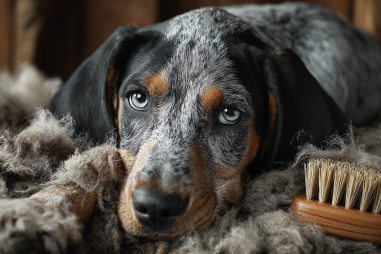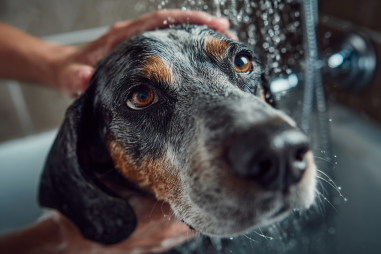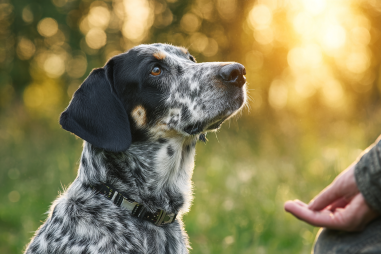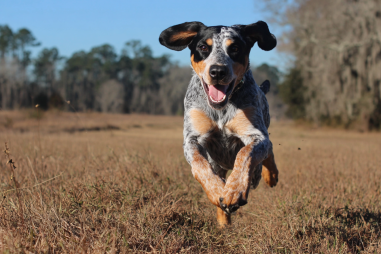The Bluetick Coonhound is renowned for its remarkable scent tracking abilities, making it one of the most effective breeds in the world of tracking and hunting. With a history deeply intertwined with hunting raccoons and other game, this dog’s powerful nose and determination have earned it a special place among scent hounds. But what exactly makes the Bluetick Coonhound’s sense of smell so impressive? And how do these dogs translate their natural abilities into practical applications? Let’s dive into the fascinating world of their scent tracking prowess.
Anatomy of the Bluetick Coonhound’s Nose
The Bluetick Coonhound’s tracking skills start with its extraordinary nose. Like many scent hounds, this breed possesses an unusually high number of olfactory receptors. While humans have around 5 million scent receptors, Bluetick Coonhounds have approximately 220 million. This abundance of receptors allows them to detect odors on a microscopic level, distinguishing between countless subtle scent molecules in the environment.
In addition to the number of receptors, the shape and structure of the Bluetick’s nose play a critical role. Their long, broad muzzle helps trap scent particles, and their large, moist nasal passages increase the surface area that comes into contact with odors. The moistness of their nose enhances their ability to capture scent molecules effectively.
Another anatomical advantage is their long, droopy ears. While it might seem odd, these ears actually help concentrate scent towards the nose by stirring up scent particles as the dog moves. This natural “scent funneling” enhances the Bluetick’s ability to follow a trail through forests, fields, or even urban areas.
How Scent Tracking Works
Scent tracking is a complex process that relies on a dog’s ability to detect, follow, and interpret chemical signals left behind by animals or people. When a Bluetick Coonhound encounters a trail, it picks up on microscopic droplets of sweat, skin cells, hair, and other biological traces that carry unique chemical signatures.
When tracking, Blueticks use a combination of their nose and brain to analyze the direction and age of a scent. They can discern whether the trail was laid minutes or hours ago, which helps them determine how fresh and relevant the trail is. Using short, rapid inhalations, they draw in scent particles and process the information quickly.
Interestingly, Bluetick Coonhounds utilize both their nostrils in a phenomenon called stereo olfaction, which is similar to how humans use both eyes to perceive depth. This allows the dog to detect differences in scent concentrations between nostrils and determine the precise direction of the trail’s source.
Applications for Hunting and Search
The Bluetick Coonhound’s excellent nose has made it a favorite for hunters for centuries. Originally bred in the southern United States to track raccoons, their ability to follow a scent trail over long distances and difficult terrains is unparalleled. Their loud baying also signals their progress to hunters, allowing for better coordination during hunts.
Beyond raccoon hunting, Bluetick Coonhounds are also skilled at tracking other game animals such as deer, bobcats, and even black bears. In these contexts, their tenacity and scent precision make them valuable hunting partners.
Outside of hunting, these dogs are often employed in search and rescue operations. Their ability to follow human scent trails through diverse environments makes them ideal candidates for finding lost individuals in wilderness areas or disaster zones. Some organizations train Blueticks specifically for this work, capitalizing on their stamina, intelligence, and olfactory abilities.
Training Scent Tracking Skills
While Bluetick Coonhounds are naturally gifted trackers, training is essential to hone their abilities and ensure they respond consistently in the field. Training typically begins with basic scent discrimination exercises, encouraging the dog to identify and follow specific odors amidst distractions.
Trainers use scent articles such as cloths with particular smells or scented dummies. Early on, the dog is rewarded for following a straightforward, fresh trail, gradually increasing difficulty by aging the scent, introducing obstacles, or using longer trails.
Socialization and obedience training are also crucial since an overly excitable dog can become distracted or overwhelmed. A well-trained Bluetick will listen to commands while remaining focused on the scent. Consistent practice in different environments helps the dog adapt to changing conditions such as weather, terrain, or competing scents.
Additionally, many trainers incorporate play and motivation into scent work, using games and praise to reinforce the tracking behavior. The Bluetick’s natural eagerness to please often makes them highly trainable and enthusiastic participants in scent tracking exercises.
Famous Scent Tracking Success Stories
There are many inspiring stories of Bluetick Coonhounds using their incredible noses to save lives and assist in challenging hunts. One notable case involved a Bluetick who helped locate a lost child in a large wooded area. Utilizing their innate tracking skills, the dog was able to follow the scent trail for miles, overcoming obstacles and environmental challenges until the child was found unharmed.
In the hunting world, countless Blueticks have earned titles and awards for tracking prowess, with their handlers praising their unyielding determination and accuracy. These dogs have been pivotal in identifying game that would otherwise be impossible to locate due to its evasive nature and the complexity of the terrain.
Search and rescue teams appreciate Blueticks for their ability to work long hours and maintain focus despite exhaustion. Their success in locating missing persons in natural disasters or wilderness search missions has bolstered their reputation as some of the best scent tracking dogs available.
What Sets Bluetick Coonhounds Apart in Scent Tracking
So, what truly distinguishes the Bluetick Coonhound from other scent hounds? While many breeds have impressive noses, it’s the combination of factors that make Blueticks exceptional:
- Exceptional olfactory anatomy: Their high receptor count and nose shape maximize scent detection.
- Persistence and stamina: Blueticks are known for their endurance, able to follow trails for hours or even days.
- Vocal communication: Their unique baying helps hunters track their progress without disrupting the environment.
- Temperament: They have a friendly, intelligent nature that makes training effective and fosters strong handler-dog bonds.
- Adaptability: Whether hunting in dense forests or tracking in urban settings, Blueticks adjust quickly to varying conditions.
All these traits combined make the Bluetick Coonhound a top choice for anyone seeking a reliable and skilled tracking dog.
Bringing It All Together
The Bluetick Coonhound’s scent tracking abilities are truly impressive, shaped by their anatomical gifts, natural instincts, and the right training. These dogs are more than just hunters’ companions — they are vital partners in search and rescue and are cherished for their loyalty and incredible noses. Whether trailing raccoons through the woods or assisting search teams in life-saving missions, Bluetick Coonhounds continue to showcase why their scent tracking skills remain highly prized. For anyone interested in scent work or hunting, the Bluetick offers an unmatched blend of talent, enthusiasm, and reliability that can make all the difference in the field.






